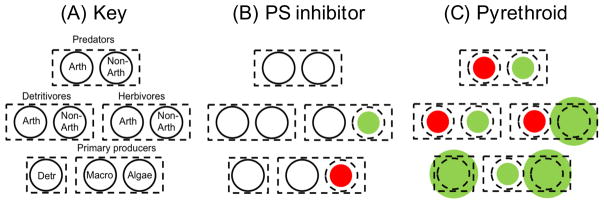Figure 2.
Chemical stressors can be used to non-randomly and indirectly manipulate food-webs. This is illustrated by empirically observed effects of continuous exposure of freshwater ditch food-webs to chemical stressors in published micro- and mesocosm experiments. A: Predators, herbivores and detritivores are separated into arthropod (Arth) and non-arthropod (Non-arth) species; primary producers are separated into macrophytes (Macro) and algae; Det. represents detrital material and its associated microflora. B: Results for exposure to 50μg•L linuron, a photosystem (‘PS’) inhibitor [58, 59]. C: Results for exposure to 35 μg•L chlorpyrifos, a pyrethroid insecticide [56, 57]. Significant primary responses by the corresponding chemical stressor are shown in red, secondary effects mediated by species interactions are shown in green. White circles indicate that there was no effect. The relative sizes of the coloured and dotted circles indicate whether the effect was positive (increase in abundance - coloured circle larger than dotted circle) or negative (decrease of abundance -coloured circle smaller than dotted circle).

